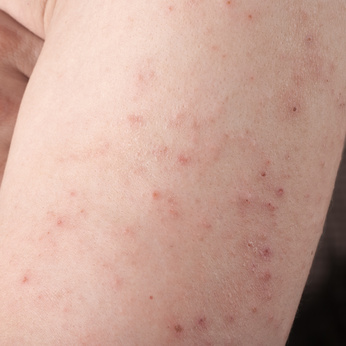The skin is the largest body part and the first line of defense. The skin is exposed to different elements and maladies every day, so it is common that you can find some skin problems. The most common skin condition is rash. Rashes are red bumps on the skin caused by irritants. A rash that comes and then goes is more irritating and difficult to treat. The main causes and corresponding treatments of skin rashes are discussed below.
Rash That Comes and Goes: 5 Possible Causes and Corresponding Treatments
Rashes are caused by irritator allergen; they come and go with different irritants and allergens. Some of the common rashes are discussed below.

1. Eczema
Eczema or dermatitis refers to several skin conditions with a similar pattern on the skin surface. It is one of the most common skin conditions, which starts with red and itchy blisters or bumps. Delayed treatment or wrong medication leads to chronic eczema. Chronic eczema causes your skin to thicken. You may also experience dryness, color changes and flaking when suffering from chronic eczema. The main cause of eczema is contact with irritants such as chemicals and allergens.
Treatment: Eczema is a rash that comes and goes, which can be treated at home by eliminating irritants. These irritants may include detergents and soaps. When suffering from eczema, avoid wearing tight-fitting or rough clothes and scratching the affected areas. It is advisable to take regular warm baths and not hot baths as a way of taking care of your skin. Medical treatments for eczema include prescription anti-inflammatory medications, steroid creams and prescription antibiotics.
2. Dry Skin Rash
A dry skin rash is common among adults. Dry skin is prone to a rash because it is easily irritated when dry and cold. A dry skin rash makes your skin extremely inflamed and itchy. This inflammation and itchiness may lead to other skin conditions that include swelling, crusting, weeping, cracking, scaling and redness. A dry skin rash comes and goes without medication, but scratching affected areasmakes it worse.
Treatment: The easiest and most important treatment for a dry skin is keeping it hydrated. You should take a minimum of eight glasses of purified water daily. Taking water consistently helps your skin retain moisture and stay hydrated. Consequently, your skin is less prone to itchiness and rashes. Another easy way to treat a dry skin rash is to avoid irritants or harsh chemicals which you may contact in cleaning, bathing or swimming. Put on protective gloves when cleaning and avoid chlorine pools. Use gentle cleansers and moisturizers when bathing and avoid chemical and additives after baths. An oatmeal bath is also effective in treating dry skin rashes because oatmeal has curative properties.
3. Hives
Hives is another rash that comes and goes, which is also an allergic reaction. Hives develop every time your skin contacts a chemical or irritant that it is allergic to. It lasts for at most a day and usually fades away without medical treatment. Hives may also result from insect bites and pollutants in your environment.
Treatment: Treatment and prevention of hives starts with identifying their cause. Once you identify the cause, avoid exposing your skin to the same allergen or chemical. In case of insect bites, avoid infestation. Seek medical attention in case hives persist for several days or if you develop angioedema or anaphylaxis symptoms.
4. Skin Fungal Infection Rash
Fungi such as dermatophytes yeasts cause skin fungal infections. Rashes from fungal infections often develop because of improper hygiene. Skin fungal infections cause different types of skin rashes that include red, itchy and scaly rashes. Some of the fine scale rashes from fungal infections resemble dry skin rashes. Fungal infections may affect one skin area or different parts of your body. If they spread to your scalp, they may lead to hair loss.
Treatment: The most common treatments for fungal infections are topical treatments, which are applied directly to the affected area(s). Fungal treatments are in various forms including creams, paints, shampoos, lotions and medicated powders. Sometimes rashes reappear after clearing when you stop applying fungal treatments. Hence, you are advised to continue applying the treatment for about two weeks after symptoms disappear. The easiest way to treat and prevent some fungal infections is keeping proper hygiene. As mentioned earlier, improper hygiene is a common cause of skin problem. Keep the affected areas clean and dry, especially in the folds of your skin.
5. Allergic Skin Rash
An allergic skin rash develops when you contact the things you are allergic to, such as food, dust and certain fabrics. Some people are also allergic to animal dander, dry air and certain chemicals. Dry skin conditions sometimes trigger allergic skin rashes.
Treatment: The easiest way to avoid and treat allergic skin rashes is to stay away from all substances that trigger them. You need to determine what you are allergic to for treatingthis kind of skin rashes. This is possible through skin and blood tests, which help you to identify the substances that trigger allergic reactions on your skin.
When to See a Doctor
A rash that comes and goes is usually possible to treat through home remedies and over-the–counter medications. Some rashes disappear without any treatment. You should seek immediate medical attention if rashes spread rapidly, are painful, or are associated with high fever, dizziness, fainting and breathing difficulties. You should also see a doctor if you develop a rash immediately after you start taking medication or eating a new type of food. See your doctor immediately if an infant develops rashes.
